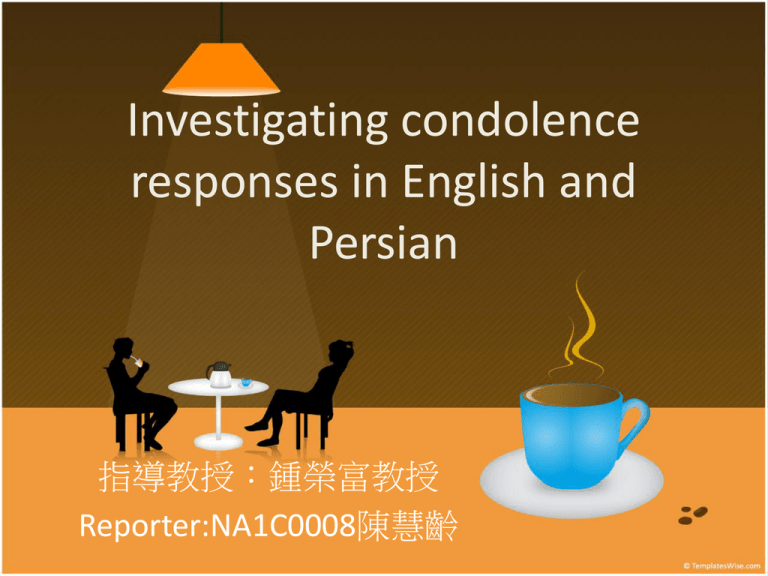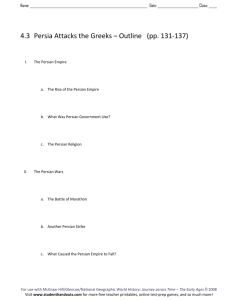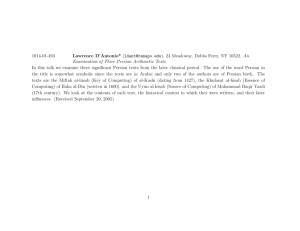Investigating condolence responses in English and Persian 指導教授:鍾榮富教授
advertisement

Investigating condolence responses in English and Persian 指導教授:鍾榮富教授 Reporter:NA1C0008陳慧齡 Introduction • With the advent of communicative approaches toward language learning, a more focused attention was directed toward using the language in authentic situations (Richards & Rodgers, 2001). • Appropriateness • Felicity conditions • According to Hudson (2000), grammatical wellformedness does not guarantee an illocution to take place appropriately. Introduction • Knowledge of pragmatics gained importance. • Riley(1981) mentioned that every discourse has specific features which can contribute to the meaning of the utterances. – formal structure – illocutionary structure – interactive structure Introduction • The knowledge of pragmatics plays an important role in conversations between individuals. • The theory of speech acts describes how one can use language to do things (Fromkin, Rodman, & Hyams,2003). – Verbs – requesting • classroom or court? Introduction • As a bereaved or as a condoler, one may be in various situations. • There is a need to acknowledge the condolence. • Various cultures may have different ways of responding to condolences. • There is no study to verify the argument. Introduction • This study aims at investigating responses to condolences in Persian and English. • The findings can be useful to reach a universal pattern of investigating condolence responses. • The present study proposes a classification for comparing Persian and English condolence responses. This study aims at dealing with the following questions: 1. Are there any significant differences among condolence responses in Persian? 2. Are there any significant differences among condolence responses in English? 3. Are there any significant differences between Persian and English with respect to condolence responses? Corpus • 200 movies – the way Persian and English speakers respond to others’ condolences Transcribed Analyzed Research Process • 7 generic categories 1. 2. 3. 4. 5. 6. 7. Token of appreciation Expressing sorrow Sharing feeling Comment on the deceased Topic avoidance Self-blame statement Divine comment The classification of comparison • The frequency of each observed category was counted and in the second phase. • Chi-square test – to find out whether there are any significant differences between Persian and English corpuses Results Table 3 Results of the Chi Square Test for the Condolence Response Types in Persian Divine > Appreciation > Deceased > Feeling/Sorrow/Self-blame/Avoidance Table 4 Results of the Chi Square Test for the Condolence Response Types in English Deceased > Feeling > Divine > Appreciation > Sorrow/Avoidance/Self-blame Table 5 Distribution of Chi-square Formula in Condolence Response Types in English and Persian there is a significant difference among Persian and English response types except for token of appreciation and topic avoidance. • This study was a cross-cultural investigation into the Persian and English condolence responses. • This paper used movies as the main source of compiling the corpus. • Movies can be utilized to provide researchers with a good pile of authentic data with little reactivity effect. • Persian speakers – divine comment – token of appreciation – comment on the deceased • Iranians are among those cultures which are highly dependent on tradition. • Most Persian speakers referred to God in their responses. • Traditional societies try to be more pluralistic and dependent. – assimilation between individuals. • Persian speakers have a high assimilative orientation in their condolence responses. • English speakers – comment on the deceased – Expressing feeling – divine comment – token of appreciation • English speakers – particularistic orientation – transmitting of the self and the personal attitudes take outmost importance • English speakers – ‘secessionist’ society – ‘I’ and the ‘self’ are emphasized. • 2 features of Persian and English cultures regarding condolence response types – both cultures use appreciation comments frequently as a way of gratitude • Persian speakers used more appreciation responses • ‘thank you’ – Persian and English speakers use topic avoidance less frequently. The orientation between Persian and English • Amersfoort (1978): universalistic subordinates concentrated subordinates Persian speakers participation in society demand equality common grounds(e.g., God) hearers’ feeling (thanking) mutual involvement (comment on the deceased) English speakers Individuals’ particularistic value system transmitting feeling and experiences Comment on the deceased expressing feeling • In Eastern societies, individuals try to represent themselves as being part of the ‘whole’(Markus & Kitayama, 1991). • Independent societies (English speakers) – individuality and self-expression • Interdependent societies(Persian speakers) – belonging and common grounds Conclusion • Persian and English speakers are significantly different in their condolence response types except for token of appreciation and topic avoidance. • Cultural factors are going to alter how speakers perform specific speech acts such as condolence. • This study can be replicated in other settings to confirm the findings of the study.





